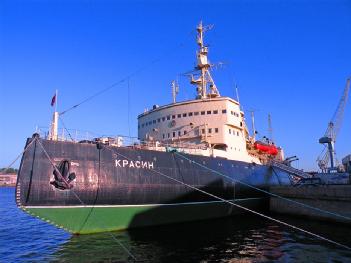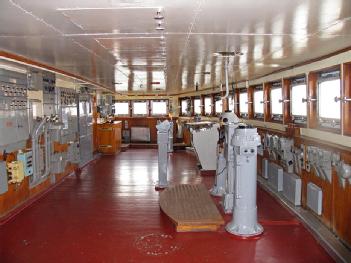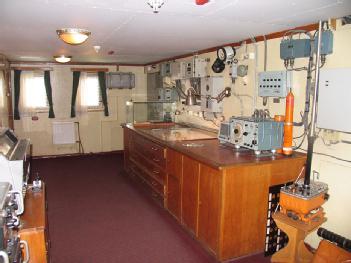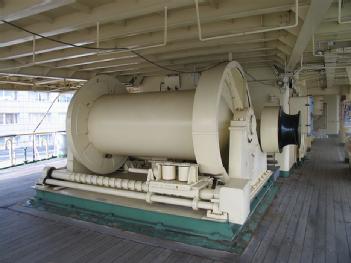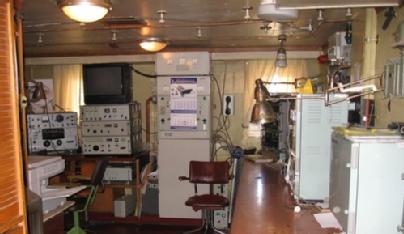
Ice-breaker «Krassin» - Ледокол «Красин» |
199106 St. Petersburg - Санкт-Петербург, Russian Federation |
|
| Address |
набережная Лейтенанта Шмидта, 23
|
| Floor area | unfortunately not known yet |
Museum typ
Exhibition
Navy / Watercraft
- Amateur Radio / Military & Industry Radio
|
Opening times
|
Wednesday - Sunday: 10.00 - 18.00; closed: every last Wednesday of a month Excursion to the Engine room (only after 14 years old) Saturday and Sunday at 13.00 and 15.00 |
||||
|
|
Adult: RUB 250; Students: RUB 150; Children: RUB 70 - Photo and video: RUB 100 | ||||
| Contact |
|
||||
| Homepage | www.krassin.ru/en | ||||
Our page for Ice-breaker «Krassin» - Ледокол «Красин» in St. Petersburg - Санкт-Петербург, Russian Federation, is not yet administrated by a Radiomuseum.org member. Please write to us about your experience with this museum, for corrections of our data or sending photos by using the Contact Form to the Museum Finder.
| Location / Directions |
metro station "Vasileostrovskaya", buses - 1, 128, trolleybus - 10 |
| Description | The ice-breaker "Krassin" is an operating ship, which has celebrated the 90th anniversary in 2007. Cabins, devices and furniture carefully save the memory of Arctic heroes.
From Wikipedia, the free encyclopedia: The icebreaker was built by Armstrong Whitworth in Newcastle upon Tyne under the supervision of Yevgeny Zamyatin. The vessel was launched as the Svyatogor on 3 August 1916 and completed in February 1917. Up to the beginning of the 1950s she remained the most powerful icebreaker in the world. After the war, the historic icebreaker took an active part in research expeditions in the Polar Ocean and led Soviet cargo convoys through the polar region. Rather than being destroyed (like the Icebreaker Yermak) to make way for more modern ships, the Krasin was preserved and restored. The vessel is now a museum ship in Saint Petersburg, the only icebreaker maritime museum commemorating the Arctic convoys. She has been fully restored to operating condition and there are plans to sail her to various European ports. Call-sign R1LK One may make contact with our radio operator by using this call-sign. The history of ice-breakerOctober 1 1916. - The icebreaker Svyatogor joins the Russian Navy's Arctic Ocean fleet.March 31, 1917. - Svyatogor hoists the St. Andrew's flag. 1918. - Scuttled in the Severnaya Dvina by the Bolsheviks to try to deny access to Arkhangel'sk to the Royal Navy. Refloated by the British and came under British control. 1920. - At the request of the Soviet Union, and flying the Norwegian flag, she was one of the icebreakers which rescued the icebreaking steamer Solovey Budimirovich (later Malygin) adrift in the ice of the Kara Sea. 1921. - Purchased from Britain by the Soviet government, with the involvement of L. Krasin and A. Krylov. 1927. - Svyatogor renamed Krasin. 1922-1928. - Operated in the Baltic Sea. 1928. - Rescued survivors from the crash of Umberto Nobile's dirigible Italia (Italy), and the German cruise-ship Monte Cervantes which had run aground off Spitsbergen. 1928-1934. - Worked in the Arctic. 1934. - Participated in the rescue of survivors of the sinking of Chelyuskin in the Chukchi Sea. 1937-1941. - Escorted freighters on the Northern Sea Route . 1941-1942. - From Vladivostok to Bremerton, Washington, USA for refit; proceeded via Panama Canal to Halifax, Nova Scotia and Reykjavik, Iceland. 1942. - Part of escort for Allied convoy PQ-15 (20 ships), Iceland to Murmansk. 1942-1943.- Escorted convoys in White and Kara seas. 1943. - Returned to Vladivostok, completing circumnavigation started in 1941. 1943-1950. - Worked in the eastern Russian Arctic. 1950-1956. - Operated by the Murmansk Shipping Company. 1956-1959.- Modernized in the Wismar shipyards, GDR (East Germany). 1959-1972.- Escorting freighters on the Northern Sea Route. 1972-1989. - Transferred to the Soviet Ministry of Geology; supporting geological exploration in the arctic. 1992. - Became a historical monument of state significance. 1995. - First exhibition opened. February 10, 2004. - Became a branch of the World Ocean Museum, St. Petersburg. March 31, 2007. - Hoisted the St. Andrew's flag again. 2008. - 80th anniversary of the rescue of Umberto Nobile's expedition and Krasin's triumphal return to Leningrad. |
Radiomuseum.org presents here one of the many museum pages. We try to bring data for your direct information about all that is relevant. In the list (link above right) you find the complete listing of museums related to "Radio & Co." we have information of. Please help us to be complete and up to date by using the contact form above.
[dsp_museum_detail.cfm]
| Data Compliance | More Information |
 yandex.ru
yandex.ru 